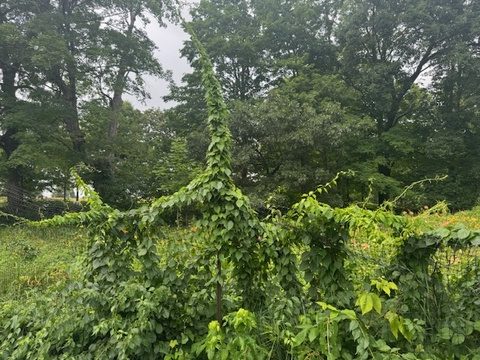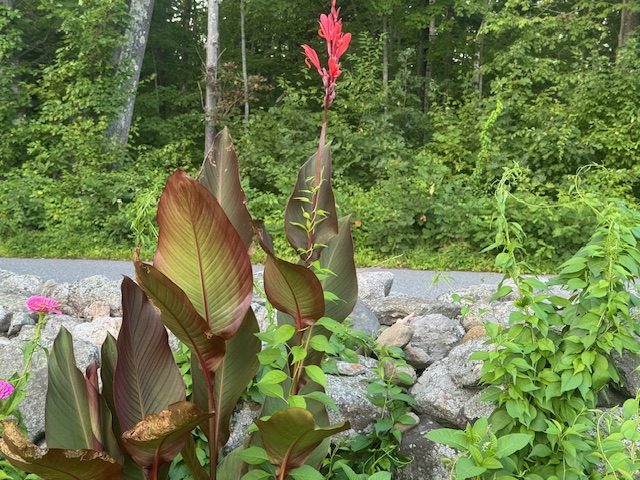
Jay wrote this story…I tend to be pretty much a live and let live type of person, and I don’t think I’ve ever really held a grudge, but I have to say that I’ve met my limit with oriental bittersweet, a vine I just absolutely hate. It’s all bitter, and no sweet. It’s invasive, kills native plants, grows extremely fast, and climbs all over everything, from stone walls, raspberry bushes, trees, flowers, and to all other plants; and spreads like the Black Plague and is extremely hard to get rid of.
However, I’ve found some approaches that seem to be working.
The approach most often suggested on the internet is basically to use RoundUp (glyphosate) or triclopyr, but I’m not a fan of these chemicals, which are sort of like using an atomic bomb, in my opinion: they certainly work, but the fallout is bad. However, in some places, particularly stone walls, it’s the only way to kill the vine, all the way down to the root.
The problem with this approach is that you have to be extremely careful, and do it on a day with little or no wind. You don’t want to spray any other plants, including trees, by accident, and you certainly don’t want to get it on you or breathe it in. I’m not going to post all the bad things that are correlated with using glyphosate, but it’s easy enough to go online and get the AI results. I guarantee you’ll be extremely careful after reading it.
Right now is pretty much the best time to use it, because you can spray the leaves, in my case on the stone walls, and if necessary you can do it again in a few days.The plant will suck that glyphosate right in and send it down to the root, killing it.
My preferred approach is more long term, but it’s quite satisfying. The concept is that although the vines are what we can see, underground there is an extensive root system, which pulls nutrients from the soil, and uses those nutrients to send up the shoots of the vines into the sunlight, where they grow rapidly and wrap around everything. Basically, all plants head for sunlight, because the photosynthesis process uses sunlight to create two things–oxygen and a type of sugar molecule (glucose).
Photosynthesis is actually the basis for all life on earth, and why plants are the base of the food chain. Even miserable bittersweet uses photosynthesis to grow its vines and in particular, its root system.
So, the trick is to not let the glucose get to the root, which we can do by simply cutting down the vines relentlessly, preventing photosynthesis. Eventually, this starves the root, which kills it.

One of the annoying things about bittersweet is that it grows really fast, so that while you are cutting it down, other shoots are popping up everywhere else. Even birds are major culprits here, as the bittersweet berries are attractive to birds, which then spread the seeds by pooping them out all over the place.
However, I’ve found that if you use a hedge trimmer to cut down a bunch of bittersweet shoots, they don’t pop back up all that fast, and if they do, spend another ten minutes with the hedge trimmer in a week or so, cutting them right back down. We are doing this at the entrance to our own driveway, and it seems to be working. Basically, if you can mow it or cut it, the plant won’t be able to make the photosynthesis as well, again starving the root.
This methodology actually takes a couple years to fully work (the internet says 3 years), but you should see progress as you continue trimming the vines back. Ideally, they’re in a place where you can mow them or hedge trimmer them. As an extreme example, we have a second field where we let the grass grow high for various animals, but unfortunately bittersweet sprouted up all over the field, so now I have to mow about half of the field that became infested, but that does do the trick. It’s not a wild field anymore, but it is now somewhat of a nice lawn. And all those bittersweet roots are not going to get their glucose.
However, just when you thought bittersweet couldn’t be any more terrible, it turns out that it contains urushiol, which is the same rash causing compound found in poison ivy and poison oak. To avoid getting a rash, or in my case, just itchy hands, you should always wear gloves when touching bittersweet. I didn’t know this at first, and couldn’t figure out why my hands were so itchy.
So I don’t mind clipping bittersweet, even though it’s pretty time consuming, because if you approach it thinking “I’m starving the root of this miserable plant”, it’s gratifying and fulfilling.
The one good thing about bittersweet is that it is extremely easy to find a photo opp of it to go along with this story.



